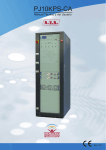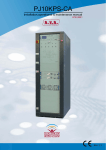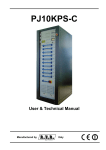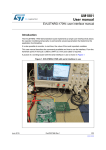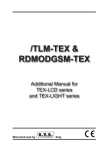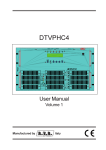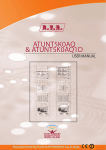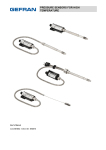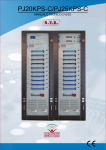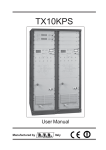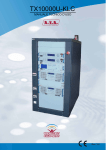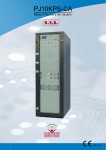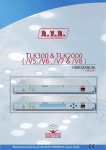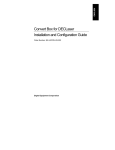Download PJ10KPS-CA - RVR Elettronica SpA Documentation Server
Transcript
PJ10KPS-CA User & Technical Manual Rev. 3.0 EC Declaration of conformity R.V.R. Elettronica S.p.A. declares that this transmitter is in conformity to the essential requirements and to other relevant regulations settled by the 1999/5/CE directive. Validity of the EC declaration of conformity. WARNING: the conformity of this product is not valid if the product is used in conditions not authorized by R.V.R. Elettronica as described in the user manual. Examples of conditions in which the conformity is not valid (indicative list): The connection between the exciter and the amplifier (i) indicated in the present document is not done properly; The components used are different from those used and recommended by R.V.R. Elettronica S.p.A.; The additional devices used are not suitable and/or are generating signals which are not suitable to those supported by the product; The product is used in operative conditions different from the normal working conditions for which the product was designed (temperature, humidity, supply voltage, …); Any modification on parts of the product without any prior authorization from R.V.R. Elettronica S.p.A.. Limitations for the use of the product in the EEC member countries. This product is a radio transmitter for FM broadcasting . It can work on operative frequencies which are not harmonized in the EEC member countries. Whoever uses this product, should obtain the authorization from the spectrum local administrative authority before starting using it. The user is responsible for the configuration of the working frequency, the output power, and for the other characteristics of the installation to which the transmitter described in the present documentation is part of, in order to respect the limitations described in the authorization received by the competent local authority. Waste Electrical or Electronic Equipment (WEEE) This symbol indicates that you should not discard waste electrical or electronic equipment (WEEE) in the trash. For proper disposal, contact your local recycling/reuse or hazardous waste center. CAUTION Do discard waste electrical or electronic equipment (WEEE) in the trash. For proper disposal, contact your local recycling/reuse or hazardous waste center. PJ10KPS-CA Index 1. 2. 3. 3.1 3.1.1 3.1.2 3.2 3.2.1 3.2.2 4. 4.1 4.2 4.3 4.4 4.5 5. 5.1 5.1.1 5.1.2 5.1.3 5.1.4 5.1.5 5.1.6 5.1.7 5.1.8 5.1.9 5.1.10 5.1.11 5.1.12 5.1.13 5.2 5.3 6. 6.1 6.1.1 6.1.2 6.1.3 6.2 6.2.1 6.2.2 6.2.3 6.2.4 6.2.5 6.2.6 6.2.7 6.2.8 6.2.9 6.2.9.1 Introduction......................................................................................... 1 Warranty..............................................................................................2 First Aid...............................................................................................4 Treatment of electrical shocks.............................................................4 If the victim is not responsive..............................................................4 If victim is responsive..........................................................................5 Treatment of electrical Burns..............................................................5 Extensive burned and broken skin......................................................5 Less severe burns...............................................................................5 General Description............................................................................ 6 Composition........................................................................................6 Technical specifications...................................................................... 7 Options................................................................................................8 Opertaing principles............................................................................9 Datasheet of MRF6VP11KHR5.......................................................... 12 Control unit (CU)................................................................................ 19 LCD Display....................................................................................... 20 Overall status menu............................................................................21 Select menu........................................................................................22 Control unit menu............................................................................... 22 Power supply menu............................................................................ 23 R.F. combiner menu............................................................................24 R.F. units menu...................................................................................25 Alarms menu...................................................................................... 26 Service menu......................................................................................26 Settings menu.....................................................................................27 Exciters menu..................................................................................... 28 Info menu............................................................................................29 Release menu.................................................................................... 29 Modem menu......................................................................................31 Buttons, selector switches and LEDs..................................................32 Alarms.................................................................................................34 Wiring diagrams..................................................................................36 Control unit (CU).................................................................................39 Core control unit (SLCCUPJ5KM2).................................................... 40 Motherboard control unit (SLCCU1PJ5KM2)......................................45 Settings...............................................................................................48 RF module.......................................................................................... 50 3-way combiner (CSCMBMOD2KPJ)................................................. 54 Pallet mosfet (KKFIN237H)................................................................ 55 Temperature probe............................................................................. 58 Spliter (CSSPLTEX1KL1)................................................................... 59 Fuse board (SLFU0359R01V01)........................................................ 60 Driver board (SLDRVRFPJ5M)...........................................................63 Pass throught board (SLFI0368R01V01)............................................66 Shunt board (SLMT0367R01V01)...................................................... 69 Bias board (SLBI0358R01V03).......................................................... 72 Settings...............................................................................................77 User & Technical Manual IV PJ10KPS-CA 6.2.10 6.2.10.1 6.2.11 6.2.11.A 6.2.11.1 6.2.12 6.2.13 6.2.14 6.2.15 6.2.16 6.2.17 6.2.18 6.3 6.3.1 6.3.2 6.3.3 6.3.4 6.3.4.1 6.3.4.2 6.3.4.3 6.3.4.4 6.4 6.5 6.5.1 6.5.2 6.5.2.1 6.5.3 6.6 6.6.1 6.6.2 6.6.2.1 6.6.3 6.6.4 6.7 6.7.1 6.8 6.9 6.10 6.11 6.11.1 6.11.1.1 6.11.2 6.11.3 7. 7.1 7.2 8. 8.1 8.2 8.3 CPU board (CPUMOD2KPJ10K)........................................................78 Settings...............................................................................................84 PFC (KPFC154)................................................................................. 85 PFC (PFCPSL4280)........................................................................... 92 PFC Settings...................................................................................... 106 Power supply (PSL4280).................................................................... 107 Directional coupler (SLDCLPFPJ10KCV)...........................................131 Low pass filter 1 (CSLPF1MOD2K).................................................... 134 Capacitor 1 (CSB1LPFPJ1KM)...........................................................135 Card outlet connector (SLOUTRFPJ5K1)...........................................135 First capacitance low pass filter (CSLP03721).................................. 136 Low pass filter 2 (CSLPF2MOD2K).................................................... 136 Electromechanical section.................................................................. 137 220/380 v wiring diagram................................................................... 140 Low tension and signal wiring diagram...............................................141 Relay interface board (CSRLYINTPJ10K).......................................... 147 P.S. combiner (PF1ADPSPJ5KM).......................................................150 P.S. combiner adapter (SLADPPPSPJ5K2)....................................... 151 CPU combiner (CPUPSCMBPJ10K).................................................. 155 CPU power supply (CPUPJ5KMC2)...................................................161 P.S. combiner trimmer.........................................................................167 Parallel interface (CSINTREMPJ5K).................................................. 168 Module box......................................................................................... 177 Tray fans (CASVTLMPJ10KVC).........................................................178 RF module I/O interface (SLIORFPJ5KM2)....................................... 181 RF module address............................................................................ 183 Power supply board tray fans (CSALVTL2KWPJ).............................. 184 Combiner and splitter......................................................................... 186 Splitter - Card measures splitter (SLSPLMEA5KW1)......................... 187 Splitter - input splitter (SLSPLINP5KW1)........................................... 190 Splitter board trimmers....................................................................... 193 Directional coupler (SL042MT1001)................................................... 194 Combiner (PF1HC510KWPJ-158)......................................................198 Emergency CCU Board (SLCCUEMPJ5K1)...................................... 199 Installation emergency CCU Board.................................................... 202 Services supply...................................................................................206 PJ10KPS-CA Ventilation.....................................................................207 Input socket........................................................................................ 208 Dummy load....................................................................................... 209 Absorber misure board (SLADKDIPK5K2)......................................... 211 Settings...............................................................................................214 Absorber measure (SLPWRSEBHC52)............................................. 215 Wiring diagram................................................................................... 218 GSM Telemetry................................................................................... 221 Dial-up via mobile............................................................................... 224 Alarms..................................................................................................225 Installation and use............................................................................ 226 Assembly............................................................................................ 226 First start.............................................................................................228 Preliminary operation......................................................................... 228 User & Technical Manual V PJ10KPS-CA 8.4 8.5 8.6 8.6.1 8.6.2 8.6.3 8.6.4 8.6.5 8.6.6 8.6.7 Power-on............................................................................................ 229 Control unit settings............................................................................ 229 Management of the exciters............................................................... 231 Start-up from power-on with exciters in manual mode....................... 231 From OFF to ON with exciters in manual........................................... 231 Automatic changeover........................................................................ 232 Phase from ON to OFF....................................................................... 232 Start-up with exciters in automatic mode............................................233 Audio alarm........................................................................................ 233 Protection and alarms.........................................................................234 User & Technical Manual VI PJ10KPS-CA 1. Introduction This manual describes the PJ10KPS-CA, a solid-state RF amplifier designed for frequency modulation sound broadcasting, manufactured by R.V.R. Elettronica S.p.A..A control system for the exciters is built into the machine so that in order to have a system with redundant exciters, all that needs to be done is to include two exciters in the transmitter such as, for example, the PTX30LCD exciters made by R.V.R. Elettronica S.p.A. This manual is written as a general guide for those having previous knowledge and experience with this kind of equipment, well conscious of the risks connected with the operation of electrical equipment. It is not intended to contain a complete statement of all safety rules which should be observed by personnel in using this or other electronic equipment. The installation, use and maintenance of this piece of equipment involve risks both for the personnel performing them and for the device itself, that shall be used only by trained personnel. . for injury or damage resulting from improper procedures or practices by untrained/unqualified personnel in the handling of this unit. Please observe all local codes and fire protection standards in the operations of this unit. WARNING: always disconnect power before opening covers or removing any part of this unit. Use appropriate grounding procedures to short out capacitors and high voltage points before servicing. WARNING: this device can irradiate radio frequency waves, and if it’s not installed following the instructions contained in the manual and local regulations it could generate interferences in radio communications. In a residential place this equipment can cause hash. In this case can be requested to user to take the necessary measures. R.V.R. Elettronica S.p.A. reserves the right to modify the design and/or the technical specifications of the product and this manual without notice. User & Technical Manual 1 PJ10KPS-CA 2. Warranty Any product of R.V.R. Elettronica is covered by a 24 (twenty four) month warranty. For components like tubes for power amplifiers, the original manufacturer’s warranty applies. R.V.R. Elettronica S.p.A. extends to the original end-user purchaser all manufacturers warranties which are transferable and all claims are to be made directly to R.V.R. per indicated procedures. Warranty shall not include: 1 Damages during shipment of this product to RVR, in case it needs to be repaired ; 2 Any unauthorized repair/modification; 3 Incidental/consequential damages as a result of any defect; 4 Nominal non-incidental defects 5 Re-shipment costs or insurance of the unit or replacement units/parts Any damage to the goods must be reported to the carrier in writing on the shipment receipt. Any discrepancy or damage discovered subsequent to delivery, shall be reported to R.V.R. Elettronica within 5 (five) days from delivery date. To claim your rights under this warranty, you should follow this procedure: 1 Contact the dealer or distributor where you purchased the unit. Describe the problem and, so that a possible easy solution can be detected. 2 Dealers and Distributors are supplied with all the information about problems that may occur and usually they can repair the unit quicker than what the manufacturer could do. Very often installing errors are discovered by dealers. 3 If your dealer cannot help you, contact R.V.R. Elettronica and explain the problem. If it is decided to return the unit to the factory, R.V.R. Elettronica will mail you a regular authorization with all the necessary instructions to send back the goods. 4 When you receive the authorization, you can return the unit. Pack it carefully for the shipment, preferably using the original packing and seal the package perfectly. The customer always assumes the risks of loss (i.e., R.V.R. is never responsible for damage or loss), until the package reaches R.V.R. premises. For this reason, we suggest you to insure the goods for the whole value. Shipment must be effected C.I.F. (PREPAID) to the address specified by R.V.R.’s service manager on the authorization 5 DO NOT RETURN UNITS WITHOUT OUR AUTHORIZATION AS THEY WILL BE REFUSED 6 Be sure to enclose a written technical report where mention all the problems found and a copy of your original invoice establishing the starting date of the warranty. User & Technical Manual 2 PJ10KPS-CA Replacement and warranty parts may be ordered from the following address. Be sure to include the equipment model and serial number as well as part description and part number. R.V.R. Elettronica SpA Via del Fonditore, 2/2c 40138 BOLOGNA ITALY Tel. +39 051 6010506 email: [email protected] Web: www.rvr.it User & Technical Manual 3 PJ10KPS-CA 3. First Aid The personnel employed in the installation, use and maintenance of the device, shall be familiar with theory and practice of first aid.. 3.1 Treatment of electrical shocks 3.1.1 If the victim is not responsive Follow the A-B-C’s of basic life support • Place victim flat on his back on a hard surface • Open airway: lift up neck, push forehead back (Fig. 3-1). • Clear out mouth if necessary and observe for breathing • if not breathing, begin artificial breathing (Figure 3-2): tilt head, pinch nostrils, make airtight seal, four quick full breaths. Remember mouth to mouth resuscitation must be commenced as soon as possible • Check carotid pulse (Fig 3-3); if pulse is absent, begin artificial circulation (Fig. 3-4) depressing sternum (Fig. 3-5) • • • In case of only one rescuer, 15 compressions alternated to two breaths. If there are two rescuers, the rhythm shall be of one brath each 5 compressions. Do not interrupt the rhythm of compressions when the second person is giving brath. Call for medical assistance as soon as possible. • User & Technical Manual 4 PJ10KPS-CA 3.1.2 • • • • 3.2 If victim is responsive Keep them warm Keep them as quiet as possible Loosen their clothing (a reclining position is recommended) Call for medical help as soon as possible Treatment of electrical Burns 3.2.1 Extensive burned and broken skin • • • • • Cover area with clean sheet or cloth Do not break blisters, remove tissue, remove adhered particles of clothing, or apply any salve or ointment. Treat victim for shock as required. Arrange transportation to a hospital as quickly as possible. If arms or legs are affected keep them elevated If medical help will not be available within an hour and the victim is conscious and not vomiting, give him a weak solution of salt and soda: 1 level teaspoonful of salt and 1/2 level teaspoonful of baking soda to each quart of water (neither hot or cold). Allow victim to sip slowly about 4 ounces (half a glass) over a period of 15 minutes. Discontinue fluid if vomiting occurs. DO NOT give alcohol 3.2.2 Less severe burns • • • • • • Apply cool (not ice cold) compresses using the cleansed available cloth article. Do not break blisters, remove tissue, remove adhered particles of clothing, or apply salve or ointment. Apply clean dry dressing if necessary. Treat victim for shock as required. Arrange transportation to a hospital as quickly as possible If arms or legs are affected keep them elevated. User & Technical Manual 5 PJ10KPS-CA 4. General Description The PJ10KPS-CA is a RF amplifier for frequency modulation sound broadcasting. It is a fully solid-state apparatus of modern design that uses MOSFET as active components in the FM amplifying modules. This chapter briefly describes the machine’s main features. 4.1 Composition The PJ10KPS-CA transmitter is made up of modules inserted in a 19” rack. The main apparatuses are: • • • • 5x RF amplifier modules at 2.2 kW nominal 1x Control unit (CU) 1x Splitter/Input RF 1x Dummy load In configuration standard it comes supplied with Rack from 32 unit. Other dimensions of the Rack always from 19” but with various heights (40 unit) are available upon request. A B C D RACK SIZE 32U 685 1580 1615 1000 40U 685 1935 1970 1000 FRONTAL VIEW SIDE VIEW (B) (C) (A) User & Technical Manual (D) 6 PJ10KPS-CA The amplifier is supplied complete with all its parts, not really "modules", essential for its operation such as the fans for dissipating the heat generated by the machine inside the room and all the accessories for the electrical and RF wiring. As a rule, the amplifier is supplied as a complete transmitter therefore the two FM exciters that it manages will be provided and connected (a service exciter and a spare exciter). 4.2 Technical specifications Frequency range: Nominal RF power: Power supply voltage: 87.5 to 108.0 MHz without any tunings 10,000 W 400V ±10% AC Three-phase, 3F+N 220V ±10% AC Three-phase, 3F+N 220V ±10% AC Mono-Phase 50/60 Hz Frequency: 50/60Hz ±2Hz Exciting power: Max 30 W Consumption: about 14.7 KW Typical Power factor: > 0.95 Efficiency: 68/70 % Weight: 350** kg (rack) - 18 kg (module) Nominal frequency deviation: ± 75 KHz (peak) Maximum frequency deviation: ± 100 KHz (peak) Rated output (load) impedance: 50 ohm unbalanced Permissible VSWR: The permissible VSWR is 1.5:1 with full power with foldback beyond 1.5:1. Harmonics suppression and spurious: Typically 85 dB RF power output connector size: 1-5/8” with EIA flange (on request 3-1/8” with EIA flange) Max. frequency tollerance: As per ITU (R) Pilot tone stability: As per ITU (R) Ambient temperature range for operation: 0° C to + 45° C Relative humidity: 95 %, non condensing. Working altitude: Up to 3000 meters AMSL * * For working heights of over 3000 meters, there are (optionally) two possibilities, according to the particular needs of the site: • extraction fan air • fans to push the air inside the rack **The value can differ in the event comes demanded the rack from 40 units User & Technical Manual 7 PJ10KPS-CA Typical power consumption of the machine: Transmitter Power (KW) 1 2 3 4 5 6 7 8 9 10 Phase Current (IR) Amp. 8.7 8.7 9.8 10.9 11.8 12.9 13.8 14.9 16.1 18.3 Phase Current (IS) Amp. 4.5 4.7 7.1 9.6 11.9 14.3 16.7 19.3 22.1 24.3 Phase Current (IT) Amp. 4.4 9.9 12.3 14.2 16.1 18.1 20.1 21.6 23.1 24.2 Neutral Current (IN) Amp. 4.7 5.4 5.2 4.9 5 5.3 5.9 6.2 6.7 6.1 Additional important features of the PJ10KPS-CA are as follows: ● ● ● ● ● The 2.2 kW amplifying modules are implemented by means of plug-in technology: the individual modules may be removed for performing maintenance operations, for instance, without having to turn off the transmitter. The transmitter keeps working at reduced power even if the module has been removed. This operation may be carried out without any risk of damaging the module itself, or the amplifier as a whole, thanks to the control system and to the RF connectors, the power supply and the purposely designed data-exchange. For further information refer to the maintenance section. Each module is controlled by a microprocessor-based card that checks and adjusts its operating mode. The resulting data are transmitted to the control unit. The control unit manages the changeover of the two exciters both in automatic and manual mode. The amplifier can work as usual even if the control unit is not present. In fact, the control unit may be substituted temporarily with an electromechanical interface by means of which the user may give the ON and OFF commands to the machine. However, in this case all the numeric type information will be missing and the power level remains the last one enabled before removing the control unit. Immediate power foldback under severe / damaging fault conditions of VSWR. The power of transmitter should automatically come down to a suitable safe design limit, so that the transmitter and its subsystem does not get damaged due to load mis match. Details of fold back to be provided. The foldback function, on the VSWR protection, works automatically on bias voltage and PA voltage, reducing them to ensure that the machine can work at maximum power, not to damage internal organs (mosfet, combiners and dummy load). 4.3 Options The PJ10KPS-CA envisages the following options: ● Dual exciter ● N+1 configuration ● Different kinds of exciters ● Automatic restore after safety tripping or manual restore ● Isolation transformer with surge arresters ● Electromechanical telemetry User & Technical Manual 8 PJ10KPS-CA 4.4 Operating principles This description is based on the block diagram shown in Figure 4-1. The PJ10KPS-CA amplifier essentially comprises two blocks: ● The Splitter-Coupler section ● The RF amplifier section The Splitter-Coupler section performs all the treatment of the RF signal except for the power amplification. RF Out Exc. 1 RF in -6 dB Exc. 2 RF in Splitter Coupler 2.2 kW RF sub-amplifier module 2.2 kW RF sub-amplifier module 2.2 kW RF sub-amplifier module 2.2 kW RF sub-amplifier module -6 dB C RS485 Control Unit AC in 220 V RS485 Power supply 2.2 kW RF sub-amplifier module 50 Vdc Power setting SWITCH C AC in 380 V 3F+N RS485 Figure 4-1 Block diagram of PJ10KPS-CA The RF signals generated by two exciters (in the redundant configuration) are first attenuated by 6 dB to improve the uncoupling among the stages and then connected to a coaxial relay commanded by the control unit. One of the two signals is closed on a dummy load built into the machine whereas the other signal is connected to the input splitter. The power of both signals is measured by specific directional couplers. The RF signal of the selected exciter is divided into five branches, each of which is passed to the input of an amplifying module. The five RF amplifiers branches are recombined by the coupler at the output of the amplifying modules. The overall amplified RF signal is filtered by a low-pass filter for eliminating the harmonics and is therefore available at the output connector. The Splitter-Coupler section is controlled by a microprocessor-based card, which makes the values detected at the various measuring points available for the user and for the diagnostics functions. User & Technical Manual 9 PJ10KPS-CA The system contains five RF sub-amplifier modules each of which is capable of supplying a maximum of 2.2 kW RF. Each RF sub-amplifier module incorporate a PFC (Power Factor Corrector) power supply that provides the utmost power efficiency for enhanced energy savings and environmental protection. Each RF sub-amplifier module contains a first stage with gain that varies (driver) according to the MOSFET BLF175. The RF signal amplified by the driver is then separated into three branches, amplified by three LDMOS MRF6VP11KHR5, recombined and filtered by a low-pass filter (Figure 4-2). Driver RF in Phase Adj. Splitter Coupler RF Out AC in 220 V 50 Vdc Vgate Vpa AC/DC DC/DC converter with convrter PFC control 360 Vdc Pallet mosfet C+bias Manual Power adj. RS485 Figure 4-2 Block diagram of RF sub-amplifier module Each RF sub-amplifier module is controlled by a microprocessor-based card, connected to the other microprocessor-based cards of the system by means of a RS485 type bus. Each RF sub-amplifier module runs the Automatic Power Control function for regulating the supplied power: the gain of the amplifying stages and the voltage supplied by the switching power supply unit are regulated so that the power that is output from the RF sub-amplifier module corresponds, if possible, to the set level. The overall power that the PJ10KPS-CA must supply is controlled by the microprocessorbased card of the splitter-combiner section according to the settings made on the control unit for the NOMINAL POWER and LOWER POWER parameters. User & Technical Manual 10 PJ10KPS-CA DC/DC CONVERTER PF CORRECTOR BOARD LOW PASS FILTER CONTROL CIRCUIT COMBINER 3X 800W STAGE FUSE BOARD Figure 4-3 Internal view of RF sub-amplifier module User & Technical Manual 11 DRIVER PJ10KPS-CA 4.5 Datasheet of MRF6VP11KHR5 • μ • • • • • • • • • ° ° ° θ θ ° μ ° ° © User & Technical Manual 12 PJ10KPS-CA ° μ μ μ ± ± ± μ η User & Technical Manual 13 PJ10KPS-CA ± ° ° ° η μ μ η ° μ μ User & Technical Manual 14 PJ10KPS-CA μ η μ η ° ° ° η μ η User & Technical Manual 15 PJ10KPS-CA Ω Ω Ω Manual User & Technical 16 PJ10KPS-CA User & Technical Manual 17 PJ10KPS-CA User & Technical Manual 18 PJ10KPS-CA 5. Control unit (CU) The operator controls and checks the status of the PJ10KPS-CA by means of the control unit (CU). Two control groups are present on this unit: • LCD and scroll buttons • Buttons, selector switches and LEDs User & Technical Manual 19 PJ10KPS-CA 5.1 LCD Display The operator uses the control software of the transmitter by means of a series of menus that are displayed on the LCD. Four specific keys are provided for scrolling through the menus, performing the settings and giving the commands: Pulsante OK ESC Descrizione Click this button to access a sub-menu, to enter the editing mode or to confirm a modified value. Click this button to exit from a menu or to cancel the modification of a value. Click this button to scroll inside a menu (to the right or down) or to reduce the value of a parameter being modified. Click this button to scroll inside a menu (to the left or up) or to increase the value of a parameter being modified. Trimmer for the regulation of the contrast of display the LCD When the operator is not using the various buttons to navigate, the LCD displays the preset screenful that shows the “Output Power” that it indicates the forward and reflected output power (Figure 5-1). As indicated on the preset screenful, push the ESC button to access at the “Overall Status” menù (Figure 5-2). Figure 5-1 User & Technical Manual 20 PJ10KPS-CA 5.1.1 Overall Status Menu This menu includes only indications, therefore the user cannot insert any input in its different lines.(Figure 5-2). Menù Line Timer (when enabled) Control unit Description Indication of the start and stop times of the automatic power reduction feature - see “Settings” menù Status of the control unit (Off or On) and indication of the exciter actually connected to the amplifier (Exct.1 or Exct.2) Power supply R.F. Combiner R.F. Unit - N Hours Status of the power supply board Status of the RF combiner Status of the Rf power amplifier number N (1° from the left) Timer counting the hours of operation of the transmitter. For example, this indication is useful in order to define when a maintenance operation can be made By pressing the Esc key as indicated on the last line, you can shift to the exchange screen from which you can have access to the “Select” menu (Figure 5-3). Figure 5-2 User & Technical Manual 21 PJ10KPS-CA 5.1.2 Select menu This is the exchange menu from which you can select the different sub-menus that compose the software.(Figure 5-3). In order to enter a sub-menu, select the correspondent line with the arrow buttons and press OK key. Menu Line Control unit Power supply R.F. Combiner R.F. Units Alarms Service Settings Exciters Info Release Modem Description General status of the PJ10KPS-CA Status of the power supply board Status of the RF combiner Status of the RF power amplifiers Summary of the occured alarms Service menu for the switching on/off of the modules Setting of the parameters (i.e. Power levels) Parameters of the exciters (i.e. output power, on air exciter) Information concerning the configuration of the PJ10KPS-CA Information concerning the hardware and software versions of the modules composing the unit Settings related to the optional telemetry system To return to the predefined menu press key ESC many times. Figura 5-3 5.1.3 Control Unit menu Informative menu on the inputs and the outputs of the CU of the machine.(Figure 5-4). Menu Line Ext Intl Aux Intl Exc1 A.Audio Exc2 A.Audio L.P. Timer Description Input status “external interlock” (JP4/4 parallel interface) Input status “auxiliary interlock” (JP4/5) Input status “audio alarm exciter 1” (JP4/8) Input status “audio alarm exciter 2” (JP4/9) Input status of the modality of automatic reduction of the power User & Technical Manual 22 PJ10KPS-CA Reserve 2 Reserve 3 Reserve 4 Relay Exc Exc-1 Mute Exc-2 Mute Audio Alarm Exc’s Mains Stand_by (In) Stand_by (Out) Total Eff Input status “Reserve 2” (JP8/3) Input status “Reserve 3” (JP8/4) Input status “Reserve 4” (JP8/5) Exciters exchange relay status (Off = exciter 1 on air) Exciter 1 interlock status (Off = RF power enabled) Exciter 2 interlock status (Off = RF power enabled) Output Audio Alarm status (JP47/1) Exciters power supply status (On = power supply enabled) “Stand by” input line status “Stand by” output line status from the control unit Total efficiency of the machine Figure 5-4 5.1.4 Power supply menu informative menu of PJ10KPS-CA of the machine (Figure 5-5). Menu Line Bus Fan Room T Safety Mains Clk. Blower C.B. Pwr. Fan C.B. Blower Top Blower K.M.G. Power Fan Description Supply voltage of the fans input Temperature of the air at the input of the unit Status of the safety arrest button. On indicates the functioning is enabled, Alr means the unit was arrested through the button Status of the main voltage supply. Ok indicates the presence of all phases and that their sequence is corrected, Alr means that it must verify the presence of all phases,their sequence or the fuse of one or more phases, to protection of the threephase control * Indicates the state of thermostat outlet air Indicates the state of motor protection switch input air Indicates the state of motor protection switch output air Indicates the state of the exhaust fan Indicates the status of the contactor general of the machine (not used) Indicates the state of input fan User & Technical Manual 23 PJ10KPS-CA Figure 5-5 * The threephase control and the relative fuses are found on electromechanical section. 5.1.5 R.F. Combiner menu This menu contains the information related to the RF part of the complete transmitter. (Figure 5-6). Menu Line Fwd Rfl Unbal Rej.IT Exhaust S.W.R. (External) Fwd (External) Rfl (External) Unbal Main Exc Stby Exc Temp RF-Enb Aux.Fan SET1 SET2 SET3 SET4 Description Overall emitted RF power of the transmitter Reflected RF power of the antenna Unbalancement RF power: sum of the power dissipated on the internal resistors due to unbalanecement in the RF modules Temperature of the load resistors dissipating the unbalancement power Temperature of the exhaust air (top of the transmitter) Standing Wave Ratio, calculated by the Control Unit on the basis of the measured forward and reflected power Forward power of an external transmitter (when configured for this function) Reflected power of an external transmitter (when configured for this function) Unbalancement power of an external transmitter (when configured for this function) Output power of the exciter currently on air (the one connected to the input of the RF modules) Output power of the exciter currently on the internal dummy load Status of the temperature alarm (sensor included in the combiner) RF output enable: “On” means that the RF combiner unit is giving its permission for the regular operation of the transmitter Switch for an auxiliary fan (not used in the current configurations) Status of the output “SET1”. See the Settings Menu Status of the output “SET2”. See the Settings Menu Status of the output “SET3”. See the Settings Menu Status of the output “SET4”. See the Settings Menu User & Technical Manual 24 PJ10KPS-CA Figure 5-6 5.1.6 R.F. Units menu Information menu showing the status of the RF power amplifier modules. (Figure 5-8). It is composed of 5 screens, one for each module, that can be scrolled using the arrow buttons. Menu Line Fwd Rfl Input Description Measurement of the forward power of the amplifier module Measurement of the reflected power of the amplifier module Measurement of the driving power at the input of the amplifier module V.P.A. Measurement supply voltage of the module (generated from the switching power supply included in each module) Bias.V Polarization voltage of the mosfet Temp Module temperature Driver.I Measurement of the current absorbed by the preamplifier stage MOS-N (1-3) Measurement of the current absorbed by the MOS N amplifier module (each RF module contains 3 MOS modules) Total I Measurement of the total current absorbed by the RF module Eff Efficiency of the amplifier module (Alarms) Temp Temperature alarm (Alarms) PS-Alr Anomaly in power supply (Alarms) Unit.Intl State of the RF module interlock micro-switch (Alarms) Unbal Not used RF-Enb Enabled of power distribution from part of the module Fan Percentage of fan speed of the cooling tray Figure 5-8 User & Technical Manual 25 PJ10KPS-CA 5.1.7 Alarms menu This screen describes all the registered events which are relevant to determine the probable causes of any dysfunction. The screen is composed of a variable number of pages (up to 10) in function of the number of events occurred (Figure 5-9). The last events in chronological order are shown in the first page and so on. To shift to the different pages, use the arrow buttons It is not possible to cancel the alarms visualized in this menu if not by personal RVR Menu Column Unit Err Time Date Description Module of the system which generated the failure Type of failure and description. For more information see chapter 5.3 Time (hrs and minutes) at which the failure occured Date at which the failure occured Figure 5-9 5.1.8 Service menu This menu is normally used during the maintenance operations. When this screen is visualized, the Control Unit checks the status of the modules of the unit more frequently in order to have a visualization of the different parameters as fast as possible. When this menu is entered, all the secondary functions are interrupted, therefore a possible alarm may not be visualized and registered immediately; when exiting this menu all the alarms which were temporarily put in “stand-by” are registered. If the user sets some modules in OFF modality, these will be automatically reactivated when exiting the menu. This menu is deactivated after 60 minutes if no key is selected. (Figure 5-10). Menu Line Fwd Unb RF Unit1 - On Fwd Rfl Description Forward power globally emitted by the amplifier Unbalancing power dissipated in the dummy load connected to the combiner Fields used to switch ON and OFF the amplifier modules. Forward power generated by the RF module Reflect power from the RF module User & Technical Manual 26 PJ10KPS-CA Figure 5-10 5.1.9 Settings menu This menu is used for the settings of the unit. It is therefore the menu which is used more often apart from the possible maintenance operations.(Figure 5-11). Menu Line Nominal Pwr Low Power SET1 SET2 SET3 SET4 Exc’ wait time Talk Address Time Date L.P. Timer Write Config Description Setting of the level of nominal power, expressed as a percentage of the maximum power level. This is the level that the PJ10KPS-CA must reach when the Power Nominal button is pressed, except in case of dysfunction Setting of the reduced power level, expressed as a percentage of the maximum power level. This is the level that the PJ10KPS-CA must reach when the Power Lower button is pressed, except in case of dysfunction. Level (Limit) at which the first “Power Good” level SET1 is launched. This level is expressed as a percentage of the full-scale to which SET1 is connected, indicated in the column Assign Level (Limit) at which the second “Power Good” level SET2 is launched. This level is expressed as a percentage of the full-scale to which SET2 is connected, indicated in the column Assign Level (Limit) at which the first “Reflected power” level SET3 is launched. This level is expressed as a percentage of the full-scale to which SET3 is connected, indicated in the column Assign Level (Limit) at which the second “Reflected power” level SET4 is launched. This level is expressed as a percentage of the full-scale to which SET4 is connected, indicated in the column Assign Delay before assuming the on air exciter is faulty Address of the unit in the RS485 network Visualization and setting of the internal clock of the unit Visualization and setting of the internal calendar of the unit Setting of the automatic power reduction feature: this can be “Auto” (enabled) or “Manual” (disabled). The feature consists in reducing the power to the low power level and then returning to the nominal power at fixed times. The start and stop times are set in this menu selecting “Auto”. Button for the registration of the configurations in each module of the unit. User & Technical Manual 27 PJ10KPS-CA Figure 5-11 5.1.10 Exciters menu This menu is used to configure the settings of the exciters (Figure 5-12). Menu Line Main Exc Stdby Exc Main Exciter Exct.1 Exct.2 Description Output power of the exciter currently on air Output power of the exciter currently on the internal dummy load Visualization of the “on air” exciter. When positioning the cursor on this line, with the arrow buttons and by pressing Enter, it is possible to operate the switching between the on air exciter and the exciter on dummy load. Status of the exciter 1. By positioning the cursor on this line with the arrow buttons and by pressing Enter it is possible to switch on and off the exciter. Same as Exct.1 for the second exciter Figure 5-12 Note: the exchange of the exciter and the relative cursor are available only if the logic of exchange is set to manual and the yellow LED is lit. User & Technical Manual 28 PJ10KPS-CA 5.1.11 Info menu This screen informs the user about the configuration of the transmitter. (Figure 5-13). Menu Line S.N. Talk Addr. Baud Rate Software V. Exciter Cfg. N+1 External Reset Safety Polarization Description Serial number of the transmitter Address of the RS485 port of the transmitter,it must be obligatorily 3 Baud rate of the serial port Software version installed in the CU Number of the exciters in the transmitter: this can be “Single” or “Dual” Configuration of the transmitter as a N+1 system Checking of the external Fwd, Rfl, Unbal values (Enabled or Disabled) Reboot the machine after the intervention of the SAFETY alarm. It must always be “Auto” The machine is designed to be able to transmit in the future, even with digital signals. To do this we need to change parameters on both the tensions of active devices, both on the readings of the parameters. Activating the “Analog”, the machine operates in classic analog configuration, putting “Digital” can process and transmit the digital signals. Figure 5-13 5.1.12 Release menu This menu is composed of 2 screens, that can be scrolled using the arrow buttons. The first show the address, the kind of configuration, the software version and the hardware version of all the microprocessor boards of the transmitter (Figure 5-14), the second shows the serial numbers of the modules (Figure 5-14a). Menu Line Control unit Power supply RF Combiner RF Unit 1 RF Unit 2 RF Unit 3 RF Unit 4 RF Unit 5 Description Information on the CU Information on the power supply Information of the RF combiner Information on module 1 Information on module 2 Information on module 3 Information on module 4 Information on module 5 User & Technical Manual 29 PJ10KPS-CA Menu Line S.N. -1 S.N. -2 Description Year of production of the module Serial number of the module Figure 5-14 User & Technical Manual Figure 5-14a 30 PJ10KPS-CA 5.1.13 Modem menu This screen informs the user about the configuration of the optional telemetry GSM (Figure 5-15). The parameters on this screen can be displayed only if the selector switch on the CU is located at a REMOTE location, if it is placed in the LOCAL screen appears as in Figure 5-15a. If you have not installed the telemetry box, the screen will appear the figure 5-15b. Menu Line I.D. Name S.C.N Info Dial Phone Level Status Retry Type Description Identification of the address of the transmitter, usually 1. In the case of multiple transmitters in N +1 configuration will be given numbers in ascending order, one for each transmitter Mnemonic name of the station, like place or frequency Service center number of your mobile operator Name of service provider Normally, ATDT Phone numbers that will receive the alert messages GSM signal level State Modem Number of messages to send. We suggest to set this value to at least 2, in case of problems with the SMS Service Centre. Modem type, usually GSM Figure 5-15 Figure 5-15a Figure 5-15b User & Technical Manual 31 PJ10KPS-CA 5.2 Buttons, selector switches and LEDs The typical machine-control operations are performed using the buttons of the control unit’s panel. Specific LEDs correspond to each button and selector switch for indicating the machine’s status.(Figure 5-16). Figure 5-16 The functions performed by the controls are as follows: Funzione OFF STDBY ON User & Technical Manual Descrizione Button for turning off the machine. A LED signals that the machine is OFF. In this status, the exciters and the pumps,are off. Button for setting the machine in standby. In this status the transmitter does not emit any power, but is ready to start the transmission: the main blower is on, the RF modules are not powered, the exciters are on but locked by means of an interlock. The stand-by is used to test the exciters, in fact in manual modality the operator could arrange them in base to the own requirements; coming from an “On” in manual modality, the system does not touch the interlock. Stand-by status is signalled from a LED. In manual and in stand-by the inhibit of the device doesn’t intervene on the interlock of the exciters. This could necessary when the apparatus is in configuration n+1 for verify if the exciters are operational. Button for turning on the transmitter. The RF power supply is activated. If the command is set to MANUAL CHANGEOVER EXCITER (led on), exciters will block interlock and have to go through in “exciters menu” of CU to enable them manually.The exciters should deliver a power of at least 15 W to start the transmitter. 32 PJ10KPS-CA LOC/REM ALARM RESET POWER LOWER NOMINAL POWER EXCITER CHANGEOVER Selector switch for setting the transmitter in remote or local mode. In local mode the buttons and the controls via the menus are active. In remote mode the buttons and the controls via the menus are inhibited and the commands may be given only remotely via the parallel interface or via the remote control software. Button to reset the alarm type FAULT or WARNING. Click this button to set the transmitter for supplying the nominal power level. A specific LED signals this setting. The value that corresponds to the nominal level is set by the operator using the menu settings (see 5.1.9) Click this button to set the transmitter for supplying the reduced power level. A specific LED signals this set-ting. The value that corresponds to the reduced level is set by the operator using the menus. (see 5.1.9) Use this button to set the changeover system in manual or automatic mode. The signaling LED turns on when the manual mode is selected. On performing a changeover, the exciter connected to the amplifier is deviated toward the internal dummy load and vice-versa. The operator must use the exciters menu to perform the changeover in manual mode. LED WARNING This LED indicates an attention condition (something is not working properly, but the amplifier is still running) LED FAULT This LED indicates a fault (the amplifier is blocked, and required the intervention of an operator for the restoration) This LED indicates the status of waiting (the amplifier is temporarily disabled, but will be reactivated automatically when the blockage is removed, or after a set period of time depending on the type of protection) This LED indicates an external inhibition. This check is run on the parallel interface (JP4/4) These LEDs indicate the activity of the serial bus 485 through which the CU acquires the status every second of the modules These LEDs indicate the communication between the CU and a PC connected to the RS-232 LED WAIT LED INT.LCK LED TX-BUS INT LED RS-232 TX-BUS EXT User & Technical Manual 33 PJ10KPS-CA 5.3 Alarms The menu Alarms of the control unit reports all the events connected to possible malfunctioning of the equipment or due to external causes. Each registration contains the reference to the concerned module, the kind of event and its date and hour. The module that detected the event is indicated by one of the following acronyms: • C.U. (Control Unit) • P.S. (Power supply) • R.F. X (RF module number X - from 1 to 5) • Combi (Combiner/Splitter) The type of event allows to identify the origin and the consequence of the fault. The first letter of the type of event can be one of the following: W “Wait” event that causes the temporary block of the piece of equipment that will be removed as soon as the problem is solved. R “Retry”, event that causes a temporary block of the piece of equipment, that will effect a restart attempt after a fixed lapse of time. (Max. 8 attempts) F “Fault”, event that causes the block of the equipment and requires the intervetion of an operator for the restart. E “Error”, event that doesn’t cause the interruption of the supply of power, but can reduce the functions of the equipment (e.g cannot be done the changeover function of the exciters) The possible event types are listed in the table below. Code Meaning Control Unit -E.Intl -A.Intl -Audio-1 -Audio-2 -L.P.Tmr. -Ris-2 -Ris-3 -Ris-4 -Mute Flt -Xchg Exc -Cfg. N+1 -Tmp. -Mains -C.B. Top -C.B. Blw external interlock ausiliary interlock audio alarm of exciter 1 is active audio alarm of exciter 2 is active Low power timer active reserve 2 input is active reserve 3 input is active reserve 4 input is active “Mute fault”: the mute commands (i.e. the interlock commands for the exciters) are not working, they are not connected or the connection is wrong a changeover of the exciters has been performed The machine is in Fault status because three changeover attempts havebeen performed (N+1 configuration) Power Supply the air inlet temperature is too high the phase sequence is not correct The circuit breaker of the air extractor motor blocked it The circuit breaker of the blowers transformer blocked it User & Technical Manual 34 PJ10KPS-CA -Fwd -Rfl -O.dvr In -O.dvr Ld -Unbal -Rej.l.T -Exhaust -S.W.R. -Ext.Alr. -Fwd -Rfl -In -Tmp. -Drv. I -Mos 1 I -Mos 2 I -Mos 3 I -Eff. -PS-Alr -O.Tmp. -Unbal -Replay err. -Safety Time-out Default Talk Address: 31 Device not configured Waiting for Retry: xxxx sec. Start Up in Progress Please Wait Combiner forward power above its limit reflected power above its limit overdrive (main exciter) Too much power dissipated on the internal dummy load (stand by exciter) Unbalancement power above its limit Overheating of the unbalancement (rejection) load resistors Exhaust overheating SWR above its limit external alarm for future use R.F. Unit forward power alarm module reflected power alarm module alarm input power module high temperature alarm driver current above its limit high current alarm mos1 high current alarm mos2 high current alarm mos3 efficiency too low the power supply is not supplied or is broken overheating on the module’s heatsink unbalancement power above its limit General wrong answer by the module interrogated emergency button pressed the module does not respond default address for configuration control unit is not configured to reset the pause time, press ok starting up please wait..... User & Technical Manual 35 PJ10KPS-CA 6. Wiring diagrams FRONT VIEW Control Unit RF module Emergency button Main switch Breaker module 1 and 2 Breaker module 3 and 4 Breaker module 5 and Services Electromechanical section (sliding) Exciter 1 Exciter 2 Dummy load Shuko socket with fuse User & Technical Manual 36 PJ10KPS-CA REAR AND SIDE VIEW Splitter Module box Combiner Power supply board tray fans Threephase transformer or Switching transformer for tray fans User & Technical Manual 37 PJ10KPS-CA TOP VIEW Input socket RF output GSM telemetry (opz.) Parallel interface (opz.) Power supply input Services supply IF YOU DO NOT ENTER THE BRIDGE, THE TRANSMITTER WILL NOT TURN ON (SEE CAP. 6.8) Slot for the passage of cables Air hole output Ø=300mm User & Technical Manual 38 PJ10KPS-CA 6.1 Control unit (CU) 1 2 1 2 Core control unit (SLCCUPJ5KM2) Motherboard control unit (SLCCU1PJ5KM2) User & Technical Manual 39 PJ10KPS-CA 6.7.1 Installation emergency CCU Board In the case the control unit presents a damage, it is possible assure the correct operation replacing, temporarily, the control panel with the card furnished together with the PJ10KPSCA. To effect the substitution, execute the following instructions: 1) Switch-OFF the amplifier. Remove the screw on the left side of the LCD panel, open the panel and individualize the necessary connectors to the operation of the emergency card. 1 2) 2 3 Disconnect all the cables connected to the unit control. User & Technical Manual 202 PJ10KPS-CA 3) Unscrew the crews that fix the board to the rack and remove the panel from his place. 4) Connect the three connectors precedentely identified to the entries of the board, like represented in the photo. User & Technical Manual 203 PJ10KPS-CA 5) Fix the board to the rack, in the same position in which previously had fixed the central panel of control. Do attention to fix the side of the card from which the interrupter sticks out toward the outside of the amplier. 6) Switch-ON the apparatus with general switch and activate the operation of the board putting the interrupter on the ON position. The switch has built in way to avoid the accidental operating; throw the interrupter toward the outside, go on the desired position and release the interrupter. User & Technical Manual 204 PJ10KPS-CA Now the emergency board is operative. When be used the emergency board, the amplifier acts with the parameters previously adjusted (for example: the level of power). To modify the parameters is necessary use the unit control. User & Technical Manual 205 PJ10KPS-CA 6.8 Services supply The services of PJ10KPS-CA are supplied at 220V through a dedicated transformer. Between the services, are included the microcontroller cards of RF modules, those of the combiner and power supply and the control unit. Supplying the services of the PJ10KPS-CA with an UPS (Uninterruptable Power Supply), the machine also in case of absence of mains power can be managed, naturally limitedly to the functions available (for example configuration or interrogation of the alarms registry). The normal configuration of the machine previews that the services are directly supply through the connection to the electrical mains of the machine, in order to insert an UPS is sufficient put it between the VDE on the roof, after have removed the bridge that comes supplied of series. User & Technical Manual 206 PJ10KPS-CA 6.9 PJ10KPS-CA Ventilation The input hole of the air is situated on the back cover of the rack. Input air Input air The output hole of the air is situated on the top cover of the rack. The current of output air is equal to 800 m3/ h. The diameter of the output is 300mm. Output air User & Technical Manual 207 PJ10KPS-CA 6.10 Input socket User & Technical Manual 208 PJ10KPS-CA 6.11 Dummy load 2 1 3 4 5 9 N° 1 2 3 4 5 6 7 8 9 10 11 12 13 14 14 13 12 11 10 Description Supply voltage presence indicator. Fan air inlet Not presnt DB-9 unbal power measure Blower dummy load enable Fuse out Fuse in (mains) VDE mains Fan air outlet Input 1 RF (7/16”) to KDI 1 Input 2 RF (7/16”) to KDI 2 Input 3 RF (7/16”) to KDI 3 Input 4 RF (7/16”) to KDI 4 Input 5 RF (7/16”) to KDI 5 User & Technical Manual 209 6 7 9 Code / VTL4114NH3 / / / 10 A 4A / VTL4114NH3 / / / / / 8 PJ10KPS-CA TOP VIEW (KDI MASTER) 2 1 4 1 3 5 5 2 3 4 BOTTOM VIEW (KDI SLAVE) 03 04 01 02 05 N° 1 2 3 4 5 Description Absorber misure board (master) Clickson 50° NA KDI resistor 100 Ω 800 W (termination) Absorber measure DB-15 board User & Technical Manual 210 Code SLADKDIPK5K2 SETBMET50NA RDT800J0100 SLPWRSEBHC52 SLDB15FFILF1 PJ10KPS-CA 7 GSM Telemetry R.V.R. Elettronica’s plug-in series transmitters, may be optionally fitted with the telemetry device that enables the user to remotely check all the machine’s working parameters and control some of them, and provides the transmitter with the ability to trigger “alarms” when problems arise while the transmitter is on air, possibly sending GSM Short Messages (SMS) to the maintainer’s cellular phone or to any other number stored in the machine’s memory. Telemetry is installed on the top rack of the transmitter, at the rear. The bottom part of the telemetry contains the following connectors: RS-485 I2C 18-0-18 V RS-485 I2C 18-0-18 V DB9 male connector for connecting the RS-485 bus from the CU DB9 male connector for connecting the I2C bus from the CU DB15 male to connect power from the CU User & Technical Manual 221 PJ10KPS-CA The top of the telemetry contains the following connectors: Insert the SIM card slot Bridge to connect the GSM modem SMA connector for GSM antenna or external directional antenna Powe ro Gene n ral Mode alarms Send m prese nt m Mode sg m RS-2 com. 3 Loca 2 l Waitin g sta rt MODEM RESET /PRG RS-232 FUSE 2A FUSE 2A Modem RS-232 DB 9 female connector connected to the modem internal GSM DB 9 female connector to connect the GSM modem, with telemetry, or to connect with the PC via RS-232 to the transmitter Reset/prg Button to reset the telemetry or programming Fuse 2A Fuse protection Fuse 2A Fuse protection Power on The LED on indicates that the telemetry is powered General alarms The LED on indicates that the memory of the telemetry alarms are present Modem present The LED on indicates that the GSM modem is present and correctly detected by the telemetry Send sms The LED on indicates that the GSM modem is sending SMS messages Modem com. The LED on indicates that the modem is connected RS-232 The LED blinks when you connect your PC to the RS-232 telemetry to communicate with the transmitter using the “Telecon 32bit” Local The LED on indicates that the transmitter is in LOCAL (via the selector switch on the CCU) and telemetry will not send alert messages or you can remotely connect to the transmitter Waiting start The LED blinks for about 45 on first boot. During this period, the telemetry, it analyzes the whole machine to check status and does not send alerts Note: you need to enter the bridge supplied with the telemetry between the connector MODEM and RS-232 to connect the GSM modem, otherwise will not work Nota: Please note that to fully deploy the features of this telemetry system, the you will need to sign a contract with a GSM service provider including DATA COMMUNICATIONS. User & Technical Manual 222 PJ10KPS-CA The use of the telemetry system requires the correct setting of the addresse in the connected pieces of equipment, since they communicate on a shared bus. Set the Uart address of exciter 1 to “1”, exciter 2 to “2”. To make this adjustment, from the main menu of the exciter place the cursor light on the “Admin” and click on it. Scroll down the menu next to the item “GenSt”, click on it and select “Uart Adr.” and set it to 1 on the first exciter (the lower) and 2 on the second (if present). We must now set the address on the CU, which must be absolutely 3 (this address is already set to factory). From the main menu (the one that shows the direct and reflected power), press the ESC key and then OK and move the cursor bright, on the “Settings” menu and press OK. Select the line “Talk Address” and press OK, with the UP ‘and DOWN keys’ set the parameter 3. User & Technical Manual 223 PJ10KPS-CA 7.1 Dial-up via mobile The commands that can be sent to the transmitter using SMS messages are as follows: Command Comando INFO TXON TXOFF LOWPWR NOMPWR ALARM RESET Reply Risposta name”Station: “station “nome stazione”ID: “numero identificativo”“ID number”“value”-assoluto”FWD: “valore “value”assoluto”RFL: “valore UNBAL: “value” “valore assoluto” TX Off StdBy)TX On (or (oppure TX or OffTX oppure TX StdBy)Low Power / Nom Power Audio Present / Audio Absent Alarm Present / Alarm Absent “stationstazione”name”Station: “nome ID: “numero identificativo”“ID number”TX is On “stationstazione”name”Station: “nome ID: “numero identificativo”“ID number”TX is Off “stationstazione”name”Station: “nome ID: “numero identificativo”“ID number”LowPwr OKname”Station: “station “nome stazione”number”ID: “ID “numero identificativo”NomPwr OK“stationstazione”name”Station: “nome ID: “numero identificativo”“ID number”the alarms in memory”Alarm: “List “lista of allarmi in memoria” name”Station: “station “nome stazione”ID: “numero identificativo”“ID number”ALARM RESET OK- Description Descrizione Information the Informazioni about sullo stato transmitter’s status del trasmettitore. Switching on the Accensione trasmettitore transmitters Switching off the Spegnimento transmitters trasmettitore Low power setting Attivazione Low Power Nominal power Attivazione Nominal Power setting ListLista of the alarms allarmi in in memory memoria Resetting the alarms Cancellazione allarmi in in memory memoria Every time you send a command must always return back a reply message, to confirm that the command was received and executed. The reply message may arrive within a maximum time of 5 min. After this time the command is void. WARNING: The transmitter must be in REMOTE otherwise not receive any command. User & Technical Manual 224 PJ10KPS-CA 7.2 Alarms These are the alarms that the transmitter can send: 1 Foward Power 2 Reflected Power 3 Unbalanced Power 4 5 6 No Audio PTX1 No Audio PTX2 Mains Fault (only if there is the UPS) 7 8 9 10 11 12 Fault Mod 1 Fault Mod 2 Fault Mod 3 Fault Mod 4 Fault Mod 5 Mains OK User & Technical Manual The power has dropped below the value set in SET2 (menu settings of the CU) The power has risen above the value set in SET4 (menu settings of the CU) The power on the dummy load has exceeded the 1000 W No audio input to PTX1 No audio input to PTX2 Is no longer the power supply, the transmitter is turned off, the UPS takes on the logic control, modulators and telemetry Module 1 has shut down Module 2 has shut down Module 3 has shut down Module 4 has shut down Module 5 has shut down It is not an alarm, is sent the first time you turned on the telemetry or when the mains voltage returns 225 PJ10KPS-CA 8 Installation and use This chapter contains the basic instructions for installing and using the PJ10KPS-CA amplifier. If necessary, more in-depth information about the operating principles may be traced in the next chapters. 8.1 Assembly For practical reasons and for transport safety, the machine is usually supplied disas-sembled to the customer. The assembly procedure is rather simple and can be car-ried out by any qualified technician. Caution: In order to avoid the risk of damaging the machine and/or of injuring the operators, it is advisable to closely adhere to the instructions provided below. always respect all the safety regulations and standards in force. Identify the machine components: • The rack (various components are assembled, such as the coupler, the splitter, the control unit, the main blower) [Figure 5-1 a)] • The 5 RF modules [Figure 5-1 b)] • The exciters [Figure 5-1 d)]. (As a rule the amplifier is supplied as a complete transmitter. This example shows two PTXLCD exciters produced by R.V.R. Elettronica. Usually the exciters are pre-assembled inside the rack). Check that all the components are in perfect working order. Should there be any kind of problem, for instance if there is any damage caused by the transport of the components, read the instructions associated with the Warranty at the beginning of this manual (chapter 2). 1. Install the rack in the location where the transmitter will work. The rack is mounted on wheels for simplifying its movement, therefore after having positioned it where expected, it is advisable to use the four screws at the bottom of the rack to steady it perpendicular to the ground. The transmitter is cooled by forced ventilation. The air outlet is on the machine’s roof whereas in the standard configuration the air intake is envisaged at the back of the machine. If you opt for this solution, install the machine at least 50 cm. away from the back wall, so that air can flow under optimal conditions. 2. Remove the protection panels of the RF modules . Figure 5.1 User & Technical Manual 226 PJ10KPS-CA 3 Insert the first amplifying module into the RF modules compartment [Figure 5-2]. Figure 5.2 The modules have a groove at the top and one at the bottom: insert the modules so that the guides in the compartment fit into these grooves. Slide the module until the two fixing screws fit into their seats. Then tighten the fixing screws at the same time so that the module inserts into its compartment remaining parallel until it is perfectly in place. 4. Connect the machine’s main power supply cable. Route the cable (5-pole type) through the raceway on the machine’s roof [Figure 5-5 a)] and fix the conductors to the terminals of the top [Figure 5-5 b)]. Figure a) 5.5a User & Technical Manual b) 227 Figure 5.5b PJ10KPS-CA ! Caution: The connection of the machine to the electric alimentation is performed fixing to a 5 poles cable with bare terminals to a terminal block. Making sure without any possibility of error that the cable is not under tension while working on it. It is reccomended not to turn on the machine without first have connected the RF exit to the antenna or to the dummy load! The PJ10KPS-CA requires a three power supply 3F (black, brown and grey) + N (blue) + GND (green yellow) able to give 50A for phase. Keep this requirement in mind in connecting to the personal distribution board. 5. Reposition the protection panels of the RF modules. 6. If the PJ10KPS-CA was not supplied complete with pre-assembled exciters, insert and connect the exciters into the appropriate housings. 8.2 First start This section describes the procedure for powering-on the machine the first time. For simplicity’s sake, the automatic control capacities of the exciters are temporarily disabled. 8.3 Preliminary operation Before activating this piece of equipment, the necessary connections must be performed, and in particular: • Power supply (MUST BE EQUAL TO WHICH HAS BEEN DESIGNED THE MACHINE, OTHERWISE YOU MIGHT PERMANENTLY DAMAGE, R.V.R. ELETTRONICA S.p.A. DOESN’T ASSUME RESPONSIBILITY.) • Modulating signals • RF load (antenna feeder or dummy load). The machine’s RF output is the “EIA 1 5/8” flanged type and is accessed on the roof of the PJ10KPS-CA. If a dummy load capable of dissipating the RF power generated by the transmitter is available, it is advisable to run the first tests by connecting to it rather than to the transmission antenna. User & Technical Manual 228 PJ10KPS-CA 8.4 Power-on When powering-on the transmitter the first time, perform the operations outlined in the table below. The “Result” column indicates the immediate results of the operations performed plus a few indications that confirm that the machine is working efficiently. Should any inconsistencies occur as compared to these indications, interrupt the procedure and identify the reason for the malfunction before resuming the procedure. OperationResult Turn the “Mains” switch The whole transmitter is powered. The machine is activated in the same status it was in when it was turned off the last time Press the OFF key of the control unit RF emission by the transmitter is inhibited; the exciters are off; the RF amplifier modules are off Press the EXCITER CHANGEOVER key of the control unit The automatic management for the exciters changeover is disabled. The MANUAL LED must be on (otherwise press the key again) Press the STDBY key of the control unit The exciters are turned on in interlock status. The RF amplifying modules stay disabled. Being in manual modality, the exciters could be unlocked to verify the operation (see 8.5). Set the parameters of the control unit This procedure is described in chapter 5 on in this manual. The control unit communicates the nominal power and reduced power values to the RF modules. It also handles the coaxial relays so that the on air exciter is the desired one and sets the exciter to ON mode Set the exciters Adhere to the instructions of the exciters used for setting the required work frequency on the exciters. Regulate the output power of the exciters to 20 W. Press POWER LOWER and ON The current exciter is activated (the interlock is released from the exciter) and its power emission is enabled. The power emitted by the PJ10KPS-CA amplifier increases gradually until it attains the level that had been set previously as “Reduced power”. Check the emitted power level by means of the analog instrument with the selector switched to FWD PWR position Press NOMINAL POWER Power supplied by PJ10KPS-CA increases and attains the set nominal value. Check it on the analog instrument. When the transmitter is on and works at its nominal power, the whole series of “accessory” checks and settings deemed necessary may be carried out before starting up the apparatus. 8.5 Control unit settings The settings of the control unit that are required for starting up the machine, mentioned in the powering-on procedure, are the following: 1. Setting of the power levels 2. Setting of the on air exciter Before performing the first operation, click the ESC and OK button. The display shows the screenful for selecting the menus [Figure 5-7]. Click the arrow keys until the cursor highlights the line associated with the Setting menu. Click OK: the software will show the associated screenful on the display [Figure 5-8]. User & Technical Manual 229 PJ10KPS-CA Figure 5-7 Figure 5-8 On having accessed the Settings menu, use the arrow keys to select the nominal power line (Pwr. Out) and click OK. Use the arrow keys to decrease or increase the indicated percentage value up to the required level. Click OK again to set this value. Repeat the operation for the line associated with the reduced power level (Pwr. Lower). NB The new power level is transmitted to the combiner module and then stored in EEPROM only when the ESC button is clicked. When inside this menu, it is advisable to check the date and time lines and update them if necessary. Note: the date and time are used only for marking the events in the alarms register. NB The date and time do not need to be updated in the transmitter in order for it to work efficiently. On having completed these settings, click ESC to return to the selection screenful. In order to set the on air exciter, select the Exciters menu [Figure 5-9]. Take into consideration the On Air Exciter line: the number to the right indicates the exciter being used. To change it simply highlight the line and click OK. To have the correct efficiency of the transmitter, the exciters should stay at 20/22 W, unless stated otherwise indicated on the modulator, depending on the version and frequency. The power of the transmitter should be adjusted from the menu “Settings”. DO NOT RESPECT THIS COULD DAMAGE THE EQUIPMENT LDMOS, RVR ELETTRONICA S.P.A. DISCLAIMS THE WARRANTY. The exchange of the exciters is assisted from the software, that is when the commutation is carried out , the interlock comes systematized in the correct way independently from like they were. The interlock could be modified also manually in case of necessity. User & Technical Manual 230 PJ10KPS-CA Figure 5-9 8.6 Management of the exciters The control unit can perform the automatic changeover between exciters if one malfunctions. The Manual LED on the panel indicates, when it is lighted up, that the automatic changeover function is disabled. In order to enable it, click the EXCITER CHANGEOVER button and check that the LED turns off. In function of the state of the PJ10KPS-CA automatism, the behavior of the machine will be various. In this chapter are described the different cases. 8.6.1 Start-up from power-on with exciters in manual mode When powering on the machine with the exciters in manual mode, the apparatus does not perform any check, both mute RF signals are active and the changeover relay remains in standby status. Use the exciters menu to activate an exciter. NB 8.6.2 This is why, if the transmitter is left in manual mode, any momentary power failure will cause the transmitter to be inactive when turned on again. Therefore it is advisable to leave the PJ10KPS-CA in automatic mode when you are not performing maintenance operations. From OFF to ON with exciters in manual When switching from OFF (or STDBY) to ON with the exciters in manual mode, the apparatus does not perform any check and the exciter that is currently set to on air is the one that is aired. If the mains signal is not OK, the exciters turn off automatically. If the maximum drive power is exceeded during operations, the PJ10KPS-CA is set to fault status and power supply is cut to the exciters. A message in the alarms menu signals this fault. When the apparatus is set to STDBY, the mute RF signals of the exciters are not activated and may be modified by the operator. When the apparatus is set to EXT INT or AUX INT, the mute RF signals of the exciters are not activated and may be modified by the operator. User & Technical Manual 231 PJ10KPS-CA 8.6.3 Automatic changeover When the PJ10KPS-CA is in the exciter automatic changeover mode, the power emitted by the on air exciter is checked constantly. If at any time the on air exciter is no longer good (i.e. power drops to below the preset level), the apparatus is kept operational whereas the exciter connected to the internal Dummy Load turns on. If the latter one is good (i.e. it is capable of supplying the required power), then the two exciters are changed over. Instead if the alternative exciter is not good, no changeover takes place, the control unit commands the mute RF of the exciter to Dummy Load, it waits 120 s. and repeats the attempt. This procedure is repeated indefinitely until one of the two exciters is considered to be good. During the whole length of time during which there is no good exciter, the PJ10KPSCA keeps the WAIT LED on for signaling this status. Each exciter is fitted with its own mute RF. On being commanded, the piloting signal must return to zero within 3 seconds at the most. If this does not occur, the fault is recorded by an error message that is entered in the alarms menu. If the mains signal is not OK, the exciters turn off automatically. If the piloting power exceeds the limit during operations, the PJ10KPS-CA is set to the FAULT status and the power supply of the exciters is turned off. A message in the alarms menu signals the fault. Keep in mind that the operator’s intervention is required to exit from the FAULT status. If the MAINS signal coming from the bus is not OK, the exciters are all turned off. As soon as the MAINS signal is regular again, the evaluation cycle of the exciters begins (see 8.6.4). When the apparatus is set to STDBY, the mute RF signals of the exciters are activated and as such both exciters are inhibited. If the ON key is pressed, the system re-evaluates both exciters in the same manner as in the procedure from OFF to ON (see 8.6.4). When the apparatus is set to EXT INT or AUX INT, the mute RF signals of the exciters are activated and therefore both exciters are inhibited. When the external interlocks are released, the system re-evaluates both exciters as during the phase from OFF to ON (see 8.6.4). 8.6.4 Phase from ON to OFF When the apparatus is set to OFF status and you press the ON button, the power supply of the exciters is activated and the logic starts to evaluate the exciters. During the evaluation phase, the WAIT LED stays ON. When the apparatus is turned OFF, it memorizes the exciter on air. Consequently when the machine restarts it can attempt to restore the previous conditions. On the machine restarting, if the exciter that is to be aired does not attain the preset power level whereas the spare one is operational, the apparatus performs the changeover when the evaluation time (120 s.) expires. User & Technical Manual 232 PJ10KPS-CA On the machine restarting, if both exciters do not attain the preset power level, the apparatus airs the one that had been present when the machine was turned off, after the evaluation time has expired. 8.6.5 Start-up with exciters in automatic mode The sequence run by the PJ10KPS-CA, when the power supply is activated while it is already in ON status and the exciters are in automatic mode, is identical to the one run for switching from OFF to ON. The only difference is that a screenful displays the countdown for determining the fault of the exciters. During this phase the manual/automatic button is inhibited and in order to set the exciters to manual mode you must press the OFF button of the apparatus. 8.6.6 Audio alarm The control unit of the PJ10KPSCA can manage a fault signal, for each exciter, which normally has an “Audio Alarm” meaning. The control software of the PJ10KPSCA does not intervene in triggering these signals since they must be checked by the exciters (or by any other connected devices). The Audio Alarm signals are made up of two inputs for the logical signals on the parallel interface and on the “mute RF” command connector of the exciters. The control unit manages these signals just like it manages the power good signals: • Each “Audio alarm” signal is associated with its own exciter • If the audio signal, associated with the exciter that is currently on air, enters an alarm status, the PJ10KPS-CA waits for the time configured in the exciter menu before it attempts the restoring operation • If the audio of the aired exciter is still in alarm status on the elapsing of the aforesaid time interval, the control unit checks if the audio of the exciter on the dummy load is regular. In this case the changeover between the exciters is performed. Observe the following differences as compared to the case in which power is missing: • The management of the “Audio alarm” signals is not active during the start-up phase and during the switching phase from OFF to ON, but only when the exciters are working in automatic. • In the standard configuration, the aforesaid sequence continues until the audio signal associated with one of the exciters becomes regular again. In the “N+1” configuration, the switching attempt is performed only twice, after which the PJ10KPS-CA enters the fault status. • An Audio Alarm output is provided on the parallel interface: this signal is activated (with no delays) when the audio of the exciter that is currently on air is in alarm status. User & Technical Manual 233 PJ10KPS-CA 8.6.7 Protection and alarms The PJ10KPS-CA contains a complete protection and alarms system, both at the individ-ual modules level and at the control unit level. The modules are fitted with a micro-processor-based system that manages any malfunctions locally. The associated information is communicated to the control unit for displaying and storing the events and for the centralized management of the events that require it. Certain LEDs of the PJ10KPS-CA panel are dedicated to the management of the alarms: LEDDescription WARNING This LED indicates a warning (something is not correctly working, but the amplifier is still working) FAULT This LED indicates a fault (the amplifier is shut off, the operator’s intervention is required) WAIT This LED indicates the wait status (the amplifier is temporarily off, it will be restarted as soon as the reason that keeps it from working will be removed, or after a fixed amount of time depending on the reason of the intervention of the protection system) The ALARM RESET button is used for resetting the alarms and restarting the machine. A complete description of the alarms and protection system is given in chapter 5.3. User & Technical Manual 234 PJ10KPS-CA AAAAAAAAAAAAAAAAAAAAAAAAAAAAAAAAAAAAAAAAAAAAAAAAAAAAAAAAAAAAAAAAAAAAAAAAAAAAAA AAAAAAAAAAAAAAAAAAAAAAAAAAAAAAAAAAAAAAAAAAAAAAAAAAAAAAAAAAAAAAAAAAAAAAAAAAAAAA AAAAAAAAAAAAAAAAAAAAAAAAAAAAAAAAAAAAAAAAAAAAAAAAAAAAAAAAAAAAAAAAAAAAAAAAAAAAAA AAAAAAAAAAAAAAAAAAAAAAAAAAAAAAAAAAAAAAAAAAAAAAAAAAAAAAAAAAAAAAAAAAAAAAAAAAAAAA AAAAAAAAAAAAAAAAAAAAAAAAAAAAAAAAAAAAAAAAAAAAAAAAAAAAAAAAAAAAAAAAAAAAAAAAAAAAAA AAAAAAAAAAAAAAAAAAAAAAAAAAAAAAAAAAAAAAAAAAAAAAAAAAAAAAAAAAAAAAAAAAAAAAAAAAAAAA AAAAAAAAAAAAAAAAAAAAAAAAAAAAAAAAAAAAAAAAAAAAAAAAAAAAAAAAAAAAAAAAAAAAAAAAAAAAAA AAAAAAAAAAAAAAAAAAAAAAAAAAAAAAAAAAAAAAAAAAAAAAAAAAAAAAAAAAAAAAAAAAAAAAAAAAAAAA AAAAAAAAAAAAAAAAAAAAAAAAAAAAAAAAAAAAAAAAAAAAAAAAAAAAAAAAAAAAAAAAAAAAAAAAAAAAAA AAAAAAAAAAAAAAAAAAAAAAAAAAAAAAAAAAAAAAAAAAAAAAAAAAAAAAAAAAAAAAAAAAAAAAAAAAAAAA AAAAAAAAAAAAAAAAAAAAAAAAAAAAAAAAAAAAAAAAAAAAAAAAAAAAAAAAAAAAAAAAAAAAAAAAAAAAAA AAAAAAAAAAAAAAAAAAAAAAAAAAAAAAAAAAAAAAAAAAAAAAAAAAAAAAAAAAAAAAAAAAAAAAAAAAAAAA AAAAAAAAAAAAAAAAAAAAAAAAAAAAAAAAAAAAAAAAAAAAAAAAAAAAAAAAAAAAAAAAAAAAAAAAAAAAAA AAAAAAAAAAAAAAAAAAAAAAAAAAAAAAAAAAAAAAAAAAAAAAAAAAAAAAAAAAAAAAAAAAAAAAAAAAAAAA AAAAAAAAAAAAAAAAAAAAAAAAAAAAAAAAAAAAAAAAAAAAAAAAAAAAAAAAAAAAAAAAAAAAAAAAAAAAAA AAAAAAAAAAAAAAAAAAAAAAAAAAAAAAAAAAAAAAAAAAAAAAAAAAAAAAAAAAAAAAAAAAAAAAAAAAAAAA AAAAAAAAAAAAAAAAAAAAAAAAAAAAAAAAAAAAAAAAAAAAAAAAAAAAAAAAAAAAAAAAAAAAAAAAAAAAAA AAAAAAAAAAAAAAAAAAAAAAAAAAAAAAAAAAAAAAAAAAAAAAAAAAAAAAAAAAAAAAAAAAAAAAAAAAAAAA AAAAAAAAAAAAAAAAAAAAAAAAAAAAAAAAAAAAAAAAAAAAAAAAAAAAAAAAAAAAAAAAAAAAAAAAAAAAAA AAAAAAAAAAAAAAAAAAAAAAAAAAAAAAAAAAAAAAAAAAAAAAAAAAAAAAAAAAAAAAAAAAAAAAAAAAAAAA AAAAAAAAAAAAAAAAAAAAAAAAAAAAAAAAAAAAAAAAAAAAAAAAAAAAAAAAAAAAAAAAAAAAAAAAAAAAAA AAAAAAAAAAAAAAAAAAAAAAAAAAAAAAAAAAAAAAAAAAAAAAAAAAAAAAAAAAAAAAAAAAAAAAAAAAAAAA AAAAAAAAAAAAAAAAAAAAAAAAAAAAAAAAAAAAAAAAAAAAAAAAAAAAAAAAAAAAAAAAAAAAAAAAAAAAAA AAAAAAAAAAAAAAAAAAAAAAAAAAAAAAAAAAAAAAAAAAAAAAAAAAAAAAAAAAAAAAAAAAAAAAAAAAAAAA AAAAAAAAAAAAAAAAAAAAAAAAAAAAAAAAAAAAAAAAAAAAAAAAAAAAAAAAAAAAAAAAAAAAAAAAAAAAAA User & Technical Manual 235 PJ10KPS-CA AAAAAAAAAAAAAAAAAAAAAAAAAAAAAAAAAAAAAAAAAAAAAAAAAAAAAAAAAAAAAAAAAAAAAAAAAAAAAA AAAAAAAAAAAAAAAAAAAAAAAAAAAAAAAAAAAAAAAAAAAAAAAAAAAAAAAAAAAAAAAAAAAAAAAAAAAAAA AAAAAAAAAAAAAAAAAAAAAAAAAAAAAAAAAAAAAAAAAAAAAAAAAAAAAAAAAAAAAAAAAAAAAAAAAAAAAA AAAAAAAAAAAAAAAAAAAAAAAAAAAAAAAAAAAAAAAAAAAAAAAAAAAAAAAAAAAAAAAAAAAAAAAAAAAAAA AAAAAAAAAAAAAAAAAAAAAAAAAAAAAAAAAAAAAAAAAAAAAAAAAAAAAAAAAAAAAAAAAAAAAAAAAAAAAA AAAAAAAAAAAAAAAAAAAAAAAAAAAAAAAAAAAAAAAAAAAAAAAAAAAAAAAAAAAAAAAAAAAAAAAAAAAAAA AAAAAAAAAAAAAAAAAAAAAAAAAAAAAAAAAAAAAAAAAAAAAAAAAAAAAAAAAAAAAAAAAAAAAAAAAAAAAA AAAAAAAAAAAAAAAAAAAAAAAAAAAAAAAAAAAAAAAAAAAAAAAAAAAAAAAAAAAAAAAAAAAAAAAAAAAAAA AAAAAAAAAAAAAAAAAAAAAAAAAAAAAAAAAAAAAAAAAAAAAAAAAAAAAAAAAAAAAAAAAAAAAAAAAAAAAA AAAAAAAAAAAAAAAAAAAAAAAAAAAAAAAAAAAAAAAAAAAAAAAAAAAAAAAAAAAAAAAAAAAAAAAAAAAAAA AAAAAAAAAAAAAAAAAAAAAAAAAAAAAAAAAAAAAAAAAAAAAAAAAAAAAAAAAAAAAAAAAAAAAAAAAAAAAA AAAAAAAAAAAAAAAAAAAAAAAAAAAAAAAAAAAAAAAAAAAAAAAAAAAAAAAAAAAAAAAAAAAAAAAAAAAAAA AAAAAAAAAAAAAAAAAAAAAAAAAAAAAAAAAAAAAAAAAAAAAAAAAAAAAAAAAAAAAAAAAAAAAAAAAAAAAA AAAAAAAAAAAAAAAAAAAAAAAAAAAAAAAAAAAAAAAAAAAAAAAAAAAAAAAAAAAAAAAAAAAAAAAAAAAAAA AAAAAAAAAAAAAAAAAAAAAAAAAAAAAAAAAAAAAAAAAAAAAAAAAAAAAAAAAAAAAAAAAAAAAAAAAAAAAA AAAAAAAAAAAAAAAAAAAAAAAAAAAAAAAAAAAAAAAAAAAAAAAAAAAAAAAAAAAAAAAAAAAAAAAAAAAAAA AAAAAAAAAAAAAAAAAAAAAAAAAAAAAAAAAAAAAAAAAAAAAAAAAAAAAAAAAAAAAAAAAAAAAAAAAAAAAA AAAAAAAAAAAAAAAAAAAAAAAAAAAAAAAAAAAAAAAAAAAAAAAAAAAAAAAAAAAAAAAAAAAAAAAAAAAAAA AAAAAAAAAAAAAAAAAAAAAAAAAAAAAAAAAAAAAAAAAAAAAAAAAAAAAAAAAAAAAAAAAAAAAAAAAAAAAA AAAAAAAAAAAAAAAAAAAAAAAAAAAAAAAAAAAAAAAAAAAAAAAAAAAAAAAAAAAAAAAAAAAAAAAAAAAAAA AAAAAAAAAAAAAAAAAAAAAAAAAAAAAAAAAAAAAAAAAAAAAAAAAAAAAAAAAAAAAAAAAAAAAAAAAAAAAA AAAAAAAAAAAAAAAAAAAAAAAAAAAAAAAAAAAAAAAAAAAAAAAAAAAAAAAAAAAAAAAAAAAAAAAAAAAAAA AAAAAAAAAAAAAAAAAAAAAAAAAAAAAAAAAAAAAAAAAAAAAAAAAAAAAAAAAAAAAAAAAAAAAAAAAAAAAA AAAAAAAAAAAAAAAAAAAAAAAAAAAAAAAAAAAAAAAAAAAAAAAAAAAAAAAAAAAAAAAAAAAAAAAAAAAAAA AAAAAAAAAAAAAAAAAAAAAAAAAAAAAAAAAAAAAAAAAAAAAAAAAAAAAAAAAAAAAAAAAAAAAAAAAAAAAA User & Technical Manual 236 PJ10KPS-CA Revision History Date Version 30/05/2013 2.0 18/07/2013 2.1 12/09/2013 2.2 16/10/2013 2.3 18/09/2013 2.4 20/09/2013 2.5-2.6-2.7 11/03/2014 2.8 Reason New version Updating Updating Updating Updating Special version Updated: CPU module diagram CPU combiner diagram CPU power supply diagram Bias board module diagram RF Power measure board (FWD) diagram RF Power measure board (RFL) diagram Dummy load diagram Editor Nicolini D. Nicolini D. Nicolini D. Nicolini D. Nicolini D. Nicolini D. Nicolini D. 01/04/14 2.9 Updated: Bias board module diagram Relay interface diagram 220/380v wiring diagram Low tension and signal wiring diagram Nicolini D. 14/05/14 3.0 Added: PFC (PFCPSL4280) diagram Updated: Directional coupler (RF module) Various codes boards Updated: Bias settings Nicolini D. © Copyright 2014 R.V.R. Elettronica S.p.A. Via del Fonditore 2/2c – 40138 Bologna Italia Telephone: +39 051 6010506 Fax: +39 051 6011104 E-mail: [email protected] Web: www.rvr.it All rights reserved Printed and bound in Italy. No part of this manual may be reproduced, memorized or transmitted in any form or by any means, electronic or mechanic, including photocopying, recording or by any information storage and retrieval system, without written permission of the copyright owner. User & Technical Manual 237 R.V.R Elettronica S.p.A. Via del Fonditore, 2 / 2c Zona Industriale Roveri · 40138 Bologna · Italy Phone: +39 051 6010506 · Fax: +39 051 6011104 e-mail: [email protected] ·web: http://www-rvr-it ISO 9001:2000 certified since 2000 The RVR Logo, and others referenced RVR products and services are trademarks of RVR Elettronica S.p.A. in Italy, other countries or both. RVR ® 1998 all rights reserved. All other trademarks, trade names or logos used are property of their respective owners.








































































